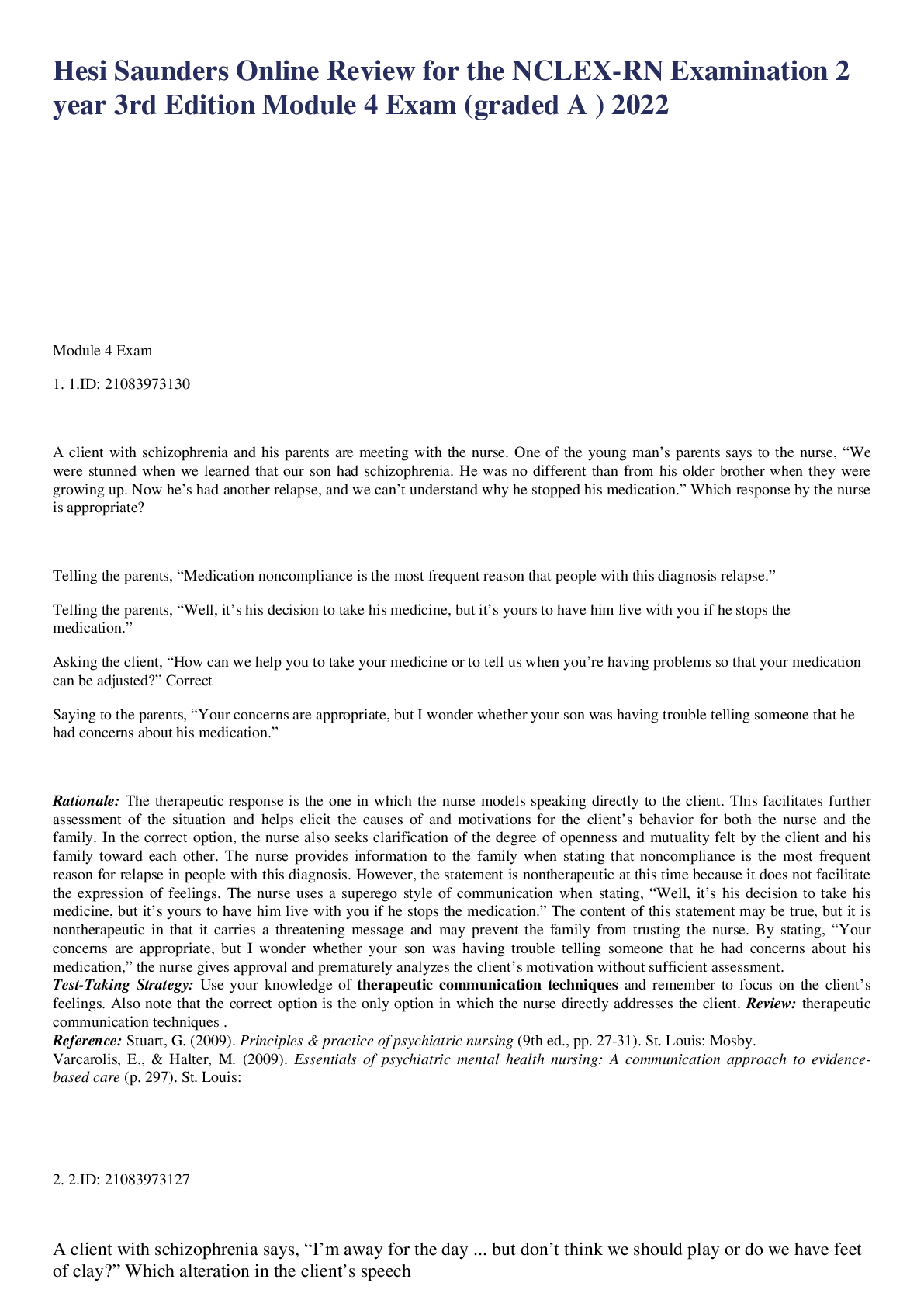*NURSING > EXAM > Comprehensive Review for the NCLEX-RN Examination, 5th Edition Pharmacology 2021 NEW DOCS (All)
Comprehensive Review for the NCLEX-RN Examination, 5th Edition Pharmacology 2021 NEW DOCS
Document Content and Description Below
1. The nurse is caring for a client in labor. The nurse reviews the physician’s prescriptions and notes that the client has a prescription for butorphanol tartrate (Stadol). The nurse understands t... hat this medication is prescribed for: 1. Pain relief 2. Increasing uterine contractions 3. Decreasing uterine contractions 4. Promoting fetal lung maturity ANS: 1 Rationale: The client in labor may be given parenteral analgesia during the first stage of labor, up to 2 to 3 hours before the anticipated delivery. Butorphanol tartrate is a medication that may be prescribed for pain relief. “Increasing uterine contractions,” “decreasing uterine contractions,” and “promoting fetal lung maturity” are not actions of this medication. Test-Taking Strategy: Knowledge of the action of butorphanol tartrate is required to answer this question. Remember that this medication is used for pain relief. Review the action of this medication if you had difficulty with this question and are unfamiliar with this medication. PTS: 1 DIF: Level of Cognitive Ability: Understanding REF: Lehne, R. (2010). Pharmacology for nursing care (7th ed.). St. Louis: Saunders. OBJ: Client Needs: Physiological Integrity TOP: Content Area: Pharmacology MSC: Integrated Process: Nursing Process—Planning 2. The postpartum nurse is caring for a client with an epidural catheter in place for opioid analgesic administration following cesarean birth. If the client develops respiratory depression and requires naloxone (Narcan) as an antidote, the client may complain of which of the following? 1. Increase in her pain level 2. Decrease in her pain level 3. Increase in the amount of itching from the opioid used in the epidural 4. Decrease in the amount of itching from the opioid used in the epidural ANS: 1 Rationale: Remember that opioids are used for epidural analgesia. Naloxone is an opioid antagonist, which reverses the effects of opioids. If it is given, the client may complain of an increase in her pain level. Therefore “decrease in her pain level,” “increase in the amount of itching from the opioid used in the epidural,” and “decrease in the amount of itching from the opioid used in the epidural” are incorrect. Test-Taking Strategy: To answer this question accurately, you must know that opioid analgesics are the medications used with epidural analgesia to relieve pain. Therefore if naloxone is administered as an antidote for an opioid analgesic, the client’s pain will increase. Review the effects of naloxone if this question was difficult. PTS: 1 DIF: Level of Cognitive Ability: Understanding REF: Lehne, R. (2010). Pharmacology for nursing care (7th ed.). St. Louis: Saunders. OBJ: Client Needs: Physiological Integrity TOP: Content Area: Pharmacology MSC: Integrated Process: Nursing Process—Assessment 3. A client experiencing preterm labor at the twenty-ninth week of gestation has been admitted to the hospital. The client has a prescription to receive betamethasone (Celestone). The nurse understands that the medication will do which of the following? 1. Prevent spontaneous delivery. 2. Stop the uterine contractions. 3. Promote maturation of the fetal lungs. 4. Accelerate the growth rate of the fetus. ANS: 3 Rationale: Betamethasone (Celestone) is classified as an anti-inflammatory and corticosteroid. It increases the surfactant level and lung maturity in the fetus, which reduces the incidence of respiratory distress syndrome. Delivery must be delayed for at least 48 hours after administration of betamethasone to allow time for the lungs of the fetus to mature. Test-Taking Strategy: Options that are comparable or alike are not likely to be correct. With this in mind, eliminate “prevent spontaneous delivery” and “stop the uterine contractions.” Note the strategic words “twenty-ninth week of gestation.” Specific knowledge about the medication and knowledge of the problems encountered by premature infants will assist in answering this question. Review the action of this medication if this question was difficult. PTS: 1 DIF: Level of Cognitive Ability: Understanding REF: McKinney, E., James, S., Murray, S., & Ashwill, J. (2009). Maternal-child nursing (3rd ed.). St. Louis: Saunders. OBJ: Client Needs: Physiological Integrity TOP: Content Area: Pharmacology MSC: Integrated Process: Nursing Process—Planning 4. A client with preeclampsia is receiving magnesium sulfate. The nurse assesses the client closely for which sign of magnesium toxicity? 1. Proteinuria 2. Hyperactive deep tendon reflexes 3. Respiratory rate of 10 breaths/min 4. Serum magnesium level of 5 mEq/L ANS: 3 Rationale: Magnesium toxicity is a risk associated with magnesium sulfate therapy. Signs of magnesium toxicity relate to central nervous system (CNS) depression and include respiratory depression, loss of deep tendon reflexes, and sudden drop in fetal heart rate and/or maternal heart rate and blood pressure. Magnesium is excreted through the kidneys. If renal impairment is present, magnesium toxicity can develop very quickly. Therapeutic serum levels of magnesium are 4 to 7 mEq/L. Test-Taking Strategy: To answer this question accurately, you must recall that magnesium sulfate is a CNS depressant. Begin to answer this question by eliminating “proteinuria” and “hyperactive deep tendon reflexes,” which are signs of preeclampsia. Select between the last two options using medication knowledge and recalling that the therapeutic serum levels of magnesium are 4 to 7 mEq/L. Review this medication and the normal magnesium level if this question was difficult. PTS: 1 DIF: Level of Cognitive Ability: Analyzing REF: Lowdermilk, D., Perry, S., & Cashion, K. (2010). Maternity nursing (8th ed.). St. Louis: Mosby. OBJ: Client Needs: Physiological Integrity TOP: Content Area: Pharmacology MSC: Integrated Process: Nursing Process—Assessment 5. A pregnant client who has human immunodeficiency virus (HIV) infection is being seen in the antenatal clinic. The nurse recalls that zidovudine (AZT) therapy will be initiated when the fetus has reached how many weeks of gestation? 1. 4 2. 14 3. 24 4. 34 ANS: 2 Rationale: The pregnant women with HIV infection will be prescribed oral AZT in the fourteenth week of gestation. Before this time, the fetus is at risk because of the teratogenic effects of the medication. In addition, a bolus of AZT is given intravenously during labor, and the neonate is treated for six weeks after birth. Test-Taking Strategy: To answer this question accurately, you must be familiar with pharmacological therapy for clients who are HIV-positive. Knowing that the fetus is most vulnerable to the effects of medications and chemicals during the period of organogenesis will assist you in selecting the correct answer. Review treatment measures for the pregnant client with HIV infection if you had difficulty with this question. PTS: 1 DIF: Level of Cognitive Ability: Understanding REF: Lehne, R. (2010). Pharmacology for nursing care (7th ed.). St. Louis: Saunders. OBJ: Client Needs: Physiological Integrity TOP: Content Area: Pharmacology MSC: Integrated Process: Nursing Process—Planning 6. The nurse has a routine prescription to instill erythromycin ointment (Ilotycin) into the eyes of a newborn. The nurse plans to explain to the parents that the purpose of the medication is to: 1. Help the newborn to see more clearly. 2. Guard against infection acquired during intrauterine life. 3. Ensure the sterility of the conjunctiva in the newborn. 4. Protect the newborn from contracting an eye infection during birth. ANS: 4 Rationale: The use of eye prophylaxis with an agent such as erythromycin protects the newborn from contracting a conjunctival infection during birth. This infection, called ophthalmia neonatorum, results from maternal vaginal infection with chlamydia or gonorrhea. This prophylaxis is mandatory in the United States. “Help the newborn to see more clearly,” “guard against infection acquired during intrauterine life,” and “ensure the sterility of the conjunctiva in the newborn” do not describe the purposes of this medication. Test-Taking Strategy: Familiarity with the purpose of this medication is needed to answer this question. Remember erythromycin protects the newborn from contracting a conjunctival infection during birth. Review the purpose of this medication if you had difficulty with this question. PTS: 1 DIF: Level of Cognitive Ability: Applying REF: Lehne, R. (2010). Pharmacology for nursing care (7th ed.). St. Louis: Saunders. OBJ: Client Needs: Health Promotion and Maintenance TOP: Content Area: Pharmacology MSC: Integrated Process: Teaching and Learning 7. The nurse has a routine prescription to administer an injection of phytonadione (vitamin K) to the newborn. Before giving the medication, the nurse explains to the client that this medication will: 1. Prevent clotting abnormalities in the newborn. 2. Stimulate the liver to produce vitamin K. 3. Prevent vitamin deficiency of fat-soluble vitamins. 4. Supplement the infant, because breast milk and formula are low in vitamin K. ANS: 1 Rationale: Vitamin K is given to the newborn to prevent clotting abnormalities. Vitamin K is usually produced by bacteria in the gastrointestinal tract, which is sterile in the newborn. The other options are incorrect reasons for administering this medication to a newborn. Test-Taking Strategy: Use the process of elimination. Thinking about the action and purpose of vitamin K will assist in answering correctly. Review the rationale for this newborn prophylaxis if this question was difficult. PTS: 1 DIF: Level of Cognitive Ability: Applying REF: Perry, S., Hockenberry, M., Lowdermilk, D., & Wilson, D. (2010). Maternal child nursing care (4th ed.). St. Louis: Mosby. OBJ: Client Needs: Physiological Integrity TOP: Content Area: Pharmacology MSC: Integrated Process: Nursing Process—Implementation 8. The client who has developed atrial fibrillation is not responding to medication therapy and has been placed on warfarin (Coumadin). The nurse is doing discharge dietary teaching with the client. The nurse would tell the client to avoid which of the following foods while taking this medication? 1. Cherries 2. Potatoes 3. Broccoli 4. Spaghetti ANS: 3 Rationale: Anticoagulant medications work by antagonizing the action of vitamin K, which is needed for clotting. When a client is taking an anticoagulant, foods high in vitamin K are often omitted from the diet. Vitamin K is found in large amounts in green leafy vegetables, such as broccoli, cabbage, turnip greens, and lettuce. The other options listed are foods that are lower in vitamin K. Test-Taking Strategy: Knowledge about the relationship between warfarin and vitamin K is needed to answer this question. Note the strategic word “avoid” in the question. This tells you that the correct option is a food that is high in vitamin K. If you had difficulty with this question, review foods high in vitamin K. PTS: 1 DIF: Level of Cognitive Ability: Applying REF: Lehne, R. (2010). Pharmacology for nursing care (7th ed.). St. Louis: Saunders. OBJ: Client Needs: Physiological Integrity TOP: Content Area: Pharmacology MSC: Integrated Process: Nursing Process—Implementation 9. A client in preterm labor is being started on intravenous magnesium sulfate to stop the contractions. The nurse checks the medication to ensure that which medication is available as an antidote if needed? 1. Magnesium oxide 2. Vitamin K 3. Aluminum hydroxide 4. Calcium gluconate ANS: 4 Rationale: The antidote for magnesium sulfate is calcium gluconate. This medication should be available if the client experiences magnesium toxicity. The other options are incorrect. “Magnesium oxide” and “aluminum hydroxide” are antacids. Vitamin K is the antidote for warfarin (Coumadin). Test-Taking Strategy: Eliminate “magnesium oxide” and “aluminum hydroxide” first because they are comparable or alike and are antacids. For the remaining options, recall that vitamin K is the antidote for warfarin (Coumadin). Remember that the antidote for magnesium sulfate is calcium gluconate. If this question was difficult, review this medication and the relationship between magnesium and calcium. PTS: 1 DIF: Level of Cognitive Ability: Applying REF: Perry, S., Hockenberry, M., Lowdermilk, D., & Wilson, D. (2010). Maternal child nursing care (4th ed.). St. Louis: Mosby. OBJ: Client Needs: Physiological Integrity TOP: Content Area: Pharmacology MSC: Integrated Process: Nursing Process—Implementation 10. The nurse had just given an intramuscular dose of methylergonovine (Methergine) to a client following delivery of an infant. The nurse determines that this medication had the intended effect after evaluating for which of the following findings? 1. Decreased pulse rate 2. Increased urine output 3. Improved uterine tone 4. Increased blood pressure ANS: 3 Rationale: Methylergonovine is an ergot alkaloid that is given following delivery to treat postpartum hemorrhage. It acts by vasoconstricting arterioles and directly stimulating uterine muscle contractions. Blood pressure may increase, but this is not the intended therapeutic effect. “Decreased pulse rate” and “increased urine output” are unrelated to the effects of this medication. Test-Taking Strategy: To answer this question accurately, recall the action of the medication and its use in the immediate postpartum period. Remember that this medication improves uterine tone. Review the action of methylergonovine if you had difficulty with this question. PTS: 1 DIF: Level of Cognitive Ability: Evaluating REF: Perry, S., Hockenberry, M., Lowdermilk, D., & Wilson, D. (2010). Maternal child nursing care (4th ed.). St. Louis: Mosby. OBJ: Client Needs: Physiological Integrity TOP: Content Area: Pharmacology MSC: Integrated Process: Nursing Process—Evaluation 11. The nurse is told that the result of a serum carbamazepine (Tegretol) level for a child who is receiving the medication for the control of seizures is 10 mcg/mL. Based on this laboratory result, the nurse anticipates that the physician will prescribe: 1. Discontinuation of the medication 2. A decrease of the dosage of the medication 3. An increase of the dosage of the medication 4. Continuation of the presently prescribed dosage ANS: 4 Rationale: When carbamazepine is administered, blood levels need to be monitored periodically to check for the child’s absorption of the medication. The amount of the medication prescribed is based on the blood level achieved. The therapeutic serum range of carbamazepine is 4 to 12 mcg/mL. The nurse would anticipate that the physician will continue the presently prescribed dosage. Test-Taking Strategy: Knowing the therapeutic serum drug level of carbamazepine will direct you to the correct option. Remember that the therapeutic serum range is 4 to 12 mcg/mL. If you had difficulty with this question, learn the therapeutic serum drug level of carbamazepine. PTS: 1 DIF: Level of Cognitive Ability: Understanding REF: McKinney, E., James, S., Murray, S., & Ashwill, J. (2009). Maternal-child nursing (3rd ed.). St. Louis: Saunders. OBJ: Client Needs: Physiological Integrity TOP: Content Area: Pharmacology MSC: Integrated Process: Nursing Process—Planning 12. The nurse is providing instructions to a mother of a child with atopic dermatitis (eczema) regarding the application of topical cortisone cream to the affected skin sites. Which of the following statements, if made by the mother, indicates an understanding of the use of this medication? 1. “I shouldn’t rub the medication into the skin.” 2. “The medication is applied everywhere except the face.” 3. “I need to wash the sites gently before I apply the medication.” 4. “I need to apply the medication generously and allow it to absorb.” ANS: 3 Rationale: Topical corticosteroids should be applied sparingly and rubbed into the area thoroughly. The affected area should be cleansed gently prior to application. It should not be applied everywhere or over extensive areas. Systemic absorption is more likely to occur with extensive application. It is applied to the affected sites. Test-Taking Strategy: Note the strategic words “indicates an understanding.” Look for the option that indicates that the mother understands how to apply the cream. Eliminate “The medication is applied everywhere except the face.” because cream should be applied only to areas that are affected. Eliminate “I need to apply the medication generously and allow it to absorb.” because of the strategic word “generously.” Eliminate “I shouldn’t rub the medication into the skin.” because of the strategic words “shouldn’t rub.” Review the procedure for application of this cream if you had difficulty with this question. PTS: 1 DIF: Level of Cognitive Ability: Evaluating REF: Perry, S., Hockenberry, M., Lowdermilk, D., & Wilson, D. (2010). Maternal child nursing care (4th ed.). St. Louis: Mosby. OBJ: Client Needs: Physiological Integrity TOP: Content Area: Pharmacology MSC: Integrated Process: Nursing Process—Evaluation 13. The nurse working in the ambulatory care center is providing medication instructions about methylphenidate (Ritalin) to the mother of a child with attention-deficit/hyperactivity disorder (ADHD). The nurse recommends that the mother give the medication to the child: 1. At bedtime 2. With the evening meal 3. Just before the noontime meal 4. In the morning, 2 hours before breakfast ANS: 3 Rationale: Methylphenidate is best taken shortly before a meal. It should not be taken after 12 noon or 1 PM for children or after 6 PM for adults, because the stimulating effect may keep the client awake. The other options are incorrect. Test-Taking Strategy: Knowledge about the correct administration procedure for this medication is required to answer this question. Remember that it is best to administer it shortly before the noontime meal. If you had difficulty with this question, review the client teaching points for methylphenidate. PTS: 1 DIF: Level of Cognitive Ability: Applying REF: Lehne, R. (2010). Pharmacology for nursing care (7th ed.). St. Louis: Saunders. OBJ: Client Needs: Physiological Integrity TOP: Content Area: Pharmacology MSC: Integrated Process: Teaching and Learning 14. A child has been prescribed to take tetracycline hydrochloride. The nurse providing medication information to the mother would plan to emphasize which of the following most important instructions about giving this medication to the child? 1. Give the medication with milk. 2. Give the medication with ice cream. 3. Mix the medication in a Styrofoam cup. 4. Use a straw when giving the medication. ANS: 4 Rationale: Because tetracycline can cause staining of the teeth, straws should be used and the mouth rinsed after administration. The medication should be administered 1 hour before or 2 hours after the administration of milk, which would eliminate “give the medication with milk” and “give the medication with ice cream.” “Mix the medication in a Styrofoam cup” is unnecessary. Test-Taking Strategy: Eliminate “give the medication with milk” and “give the medication with ice cream” first because they are comparable or alike—they are both milk products. Recalling that tetracycline can cause staining of the teeth will direct you to the correct option from those remaining. If you had difficulty with this question, review the client teaching points related to the administration of tetracycline hydrochloride. PTS: 1 DIF: Level of Cognitive Ability: Applying REF: Kee, J., Hayes, E., & McCuistion, L. (2009). Pharmacology: a nursing process approach (6th ed.). St. Louis: Saunders. OBJ: Client Needs: Physiological Integrity TOP: Content Area: Pharmacology MSC: Integrated Process: Teaching and Learning 15. The nurse is providing instructions to the parent of a child with iron deficiency anemia about the administration of a liquid oral iron supplement. Which of the following statements, if made by the parent, indicates an understanding of the administration of this medication? 1. “I should give the iron with food.” 2. “I can mix the iron with cereal to give it.” 3. “I should add the iron to the formula in the baby’s bottle.” 4. “I should use a medicine dropper and place the iron near the back of the throat.” ANS: 4 Rationale: Oral iron supplement should be administered through a straw or medicine dropper placed at the back of the mouth because it will stain the teeth. The parents should be instructed to brush or wipe the teeth after administration. Iron is administered between meals because absorption is decreased if there is food in the stomach. Iron requires an acidic environment to facilitate its absorption in the [Show More]
Last updated: 1 year ago
Preview 1 out of 277 pages
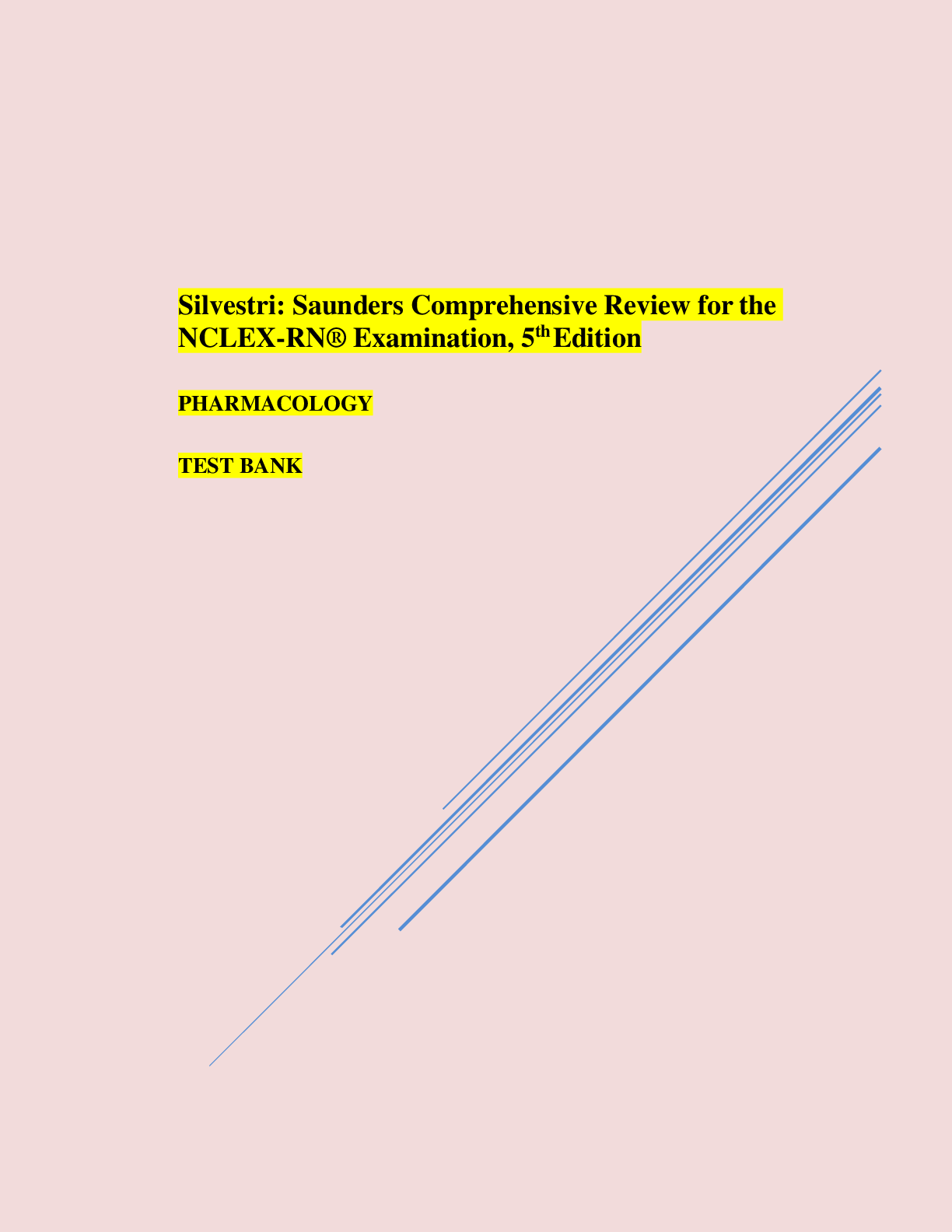
Reviews( 0 )
Document information
Connected school, study & course
About the document
Uploaded On
Mar 30, 2021
Number of pages
277
Written in
Additional information
This document has been written for:
Uploaded
Mar 30, 2021
Downloads
0
Views
64


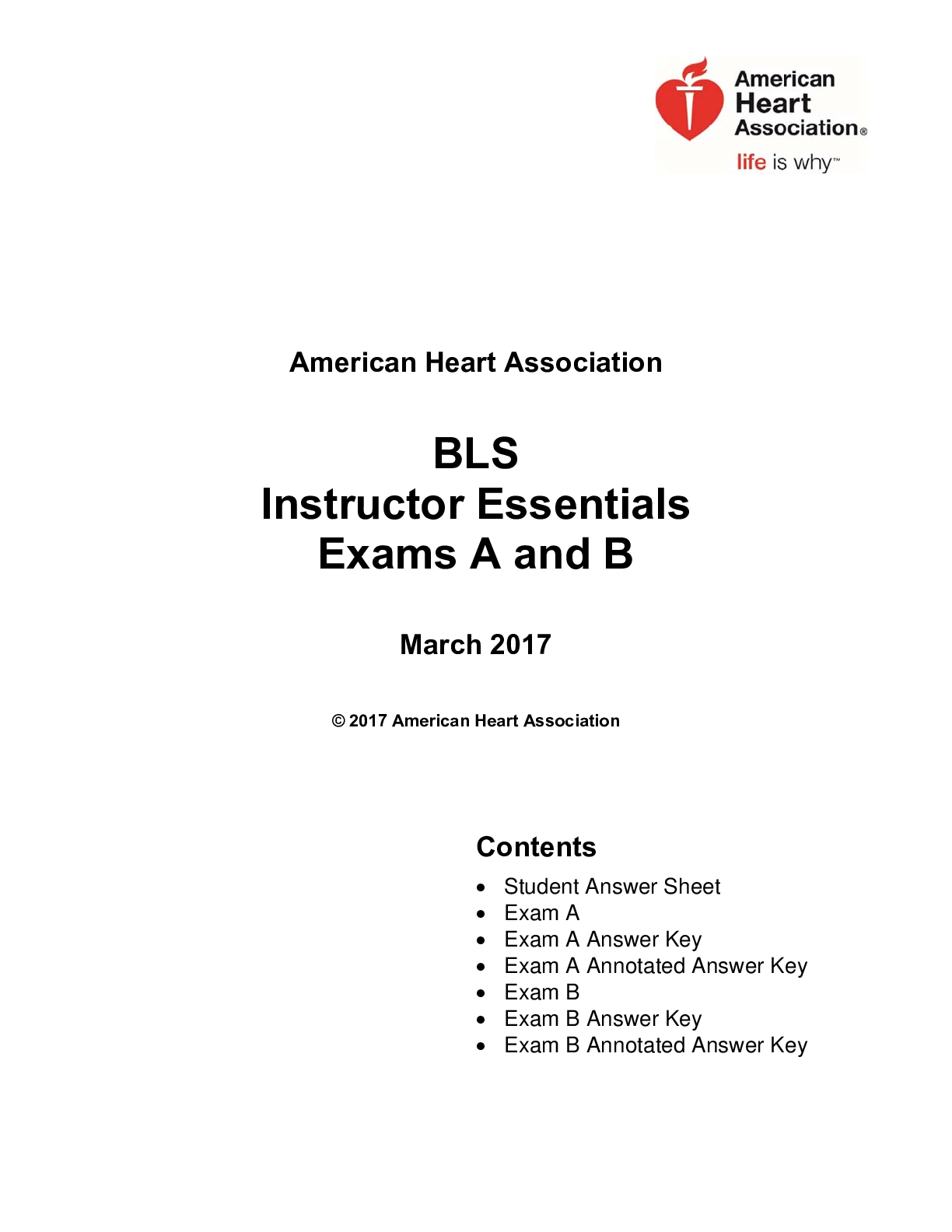
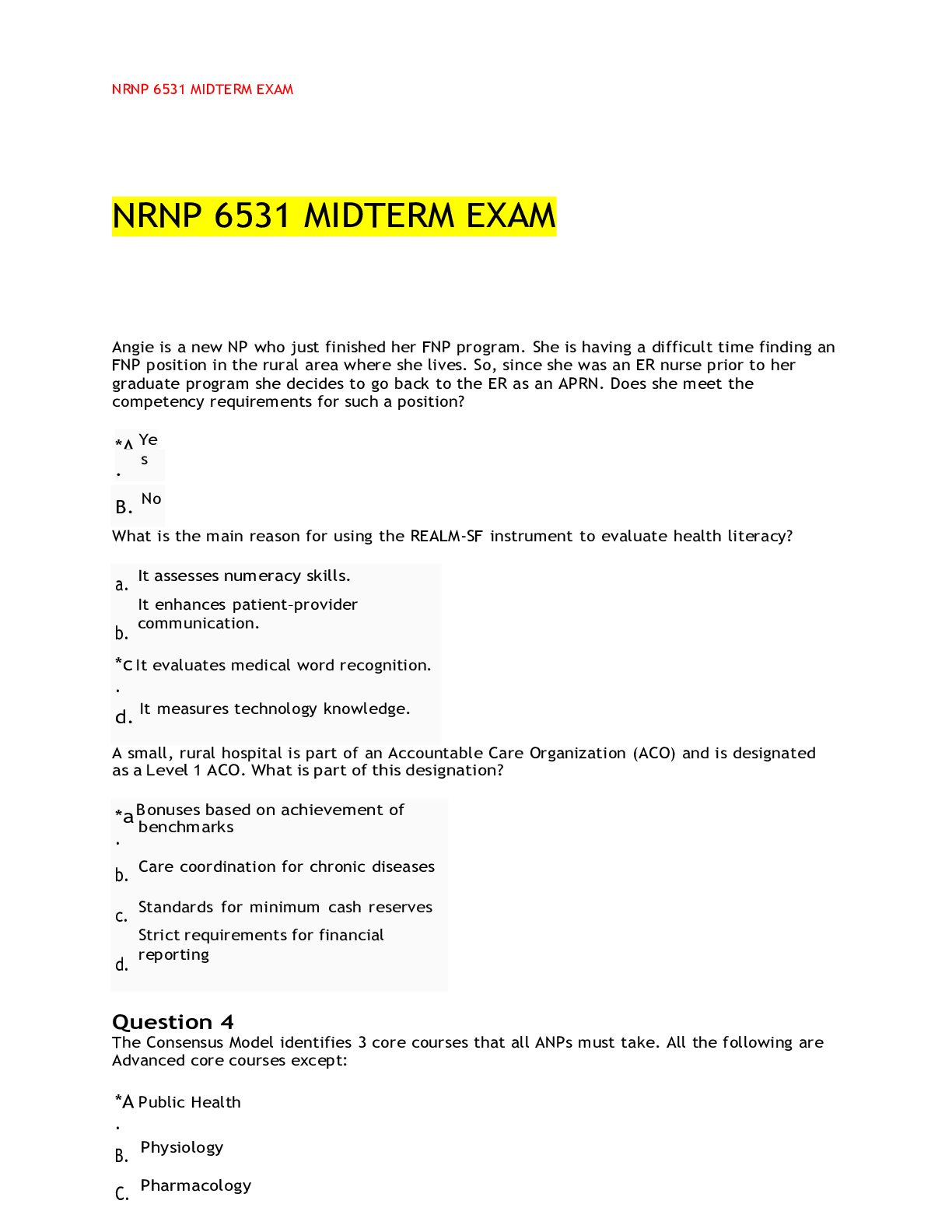
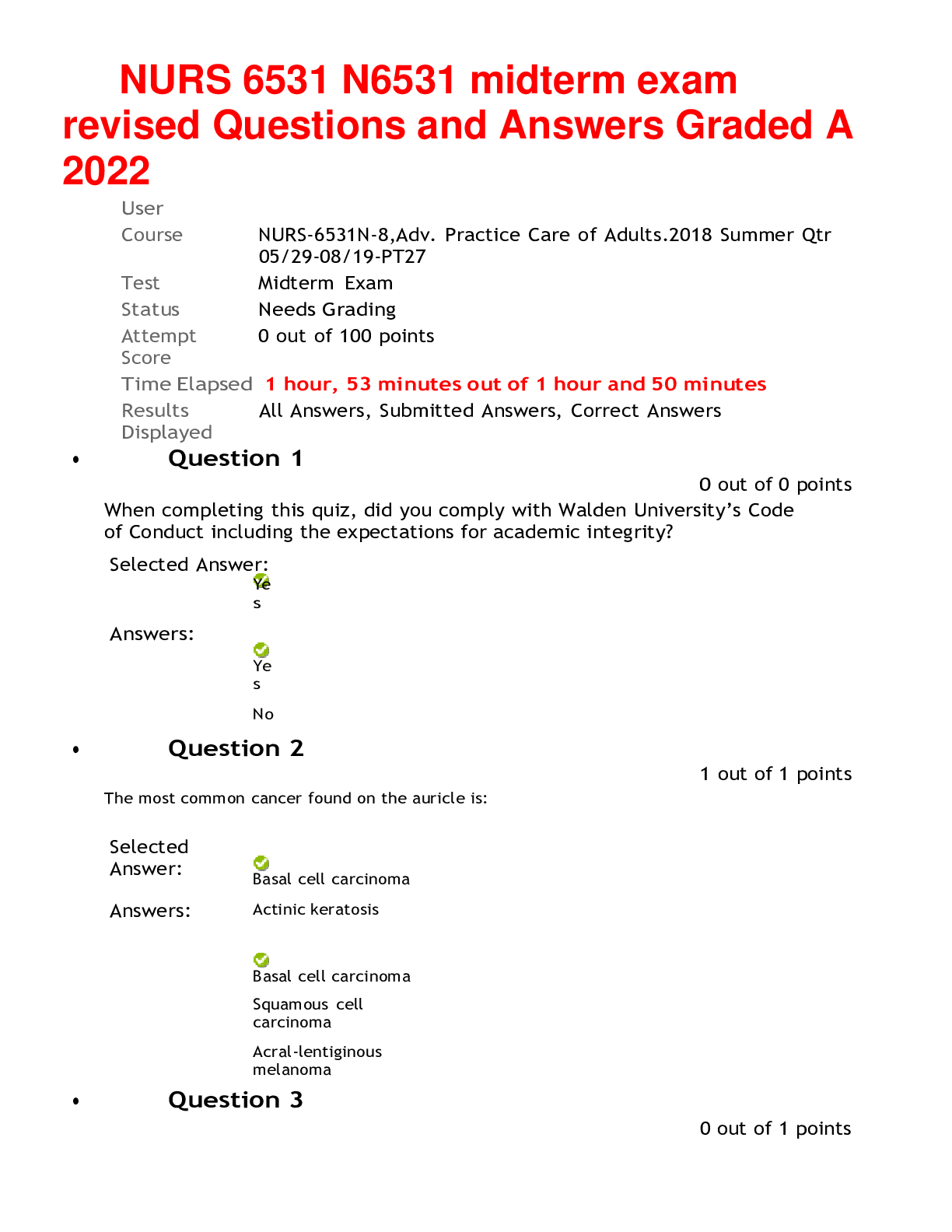
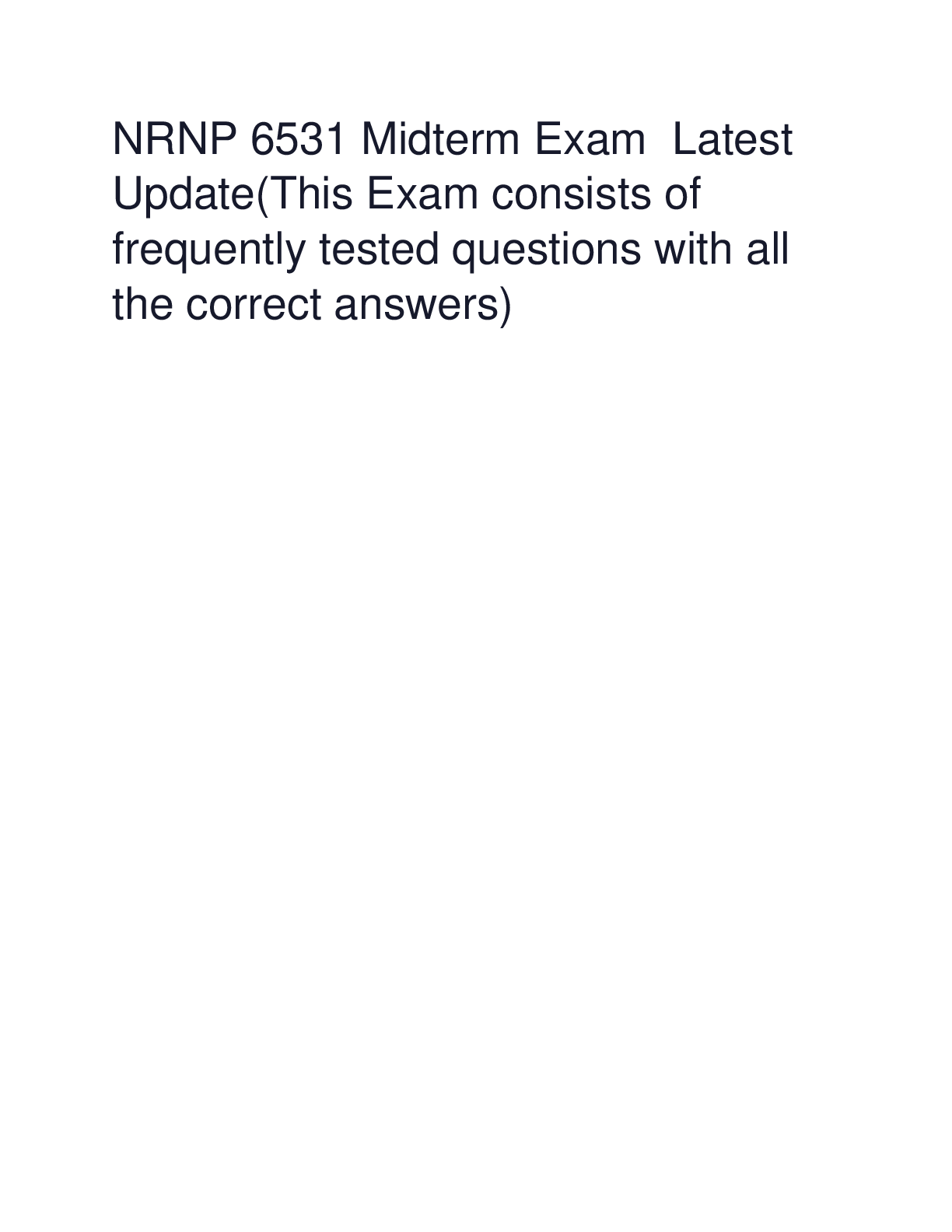

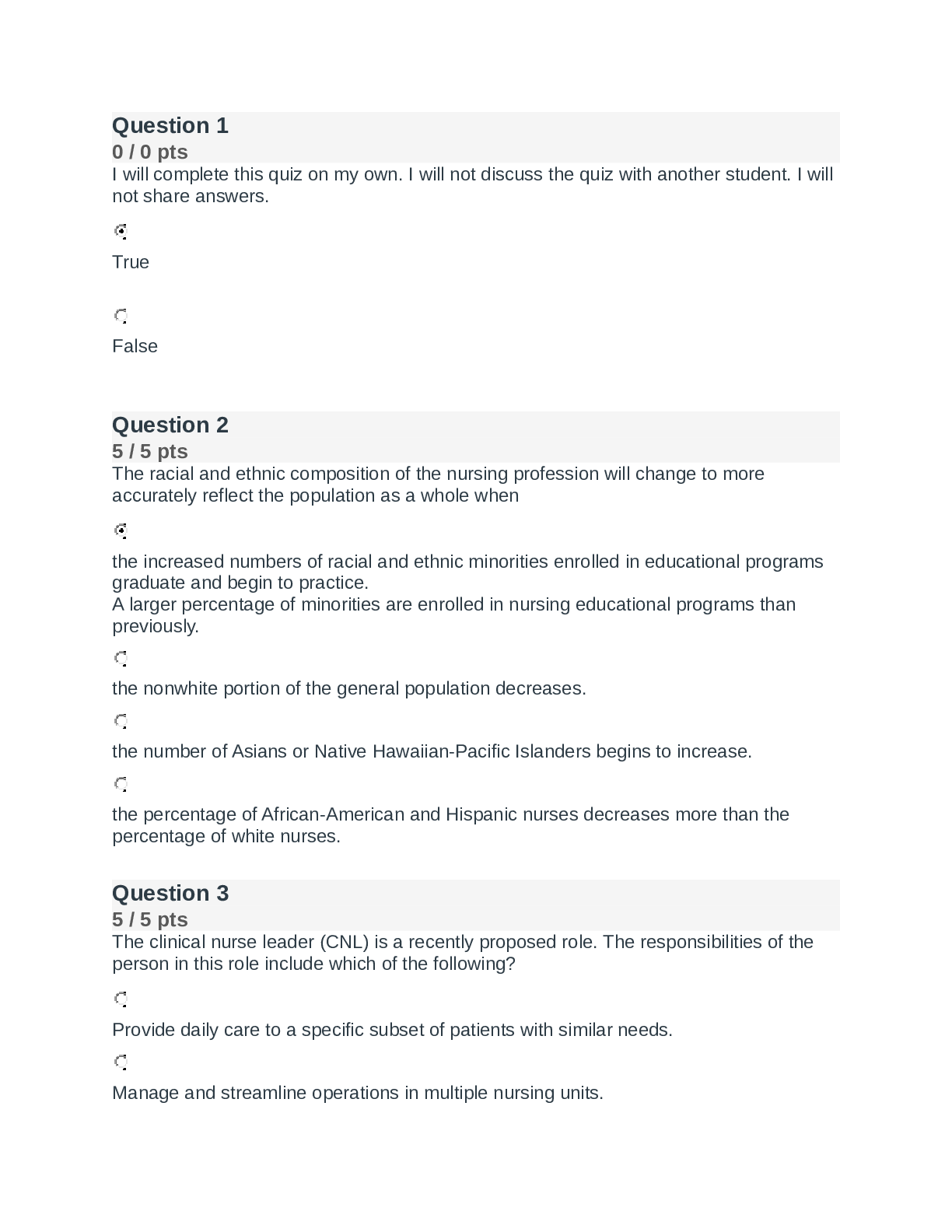

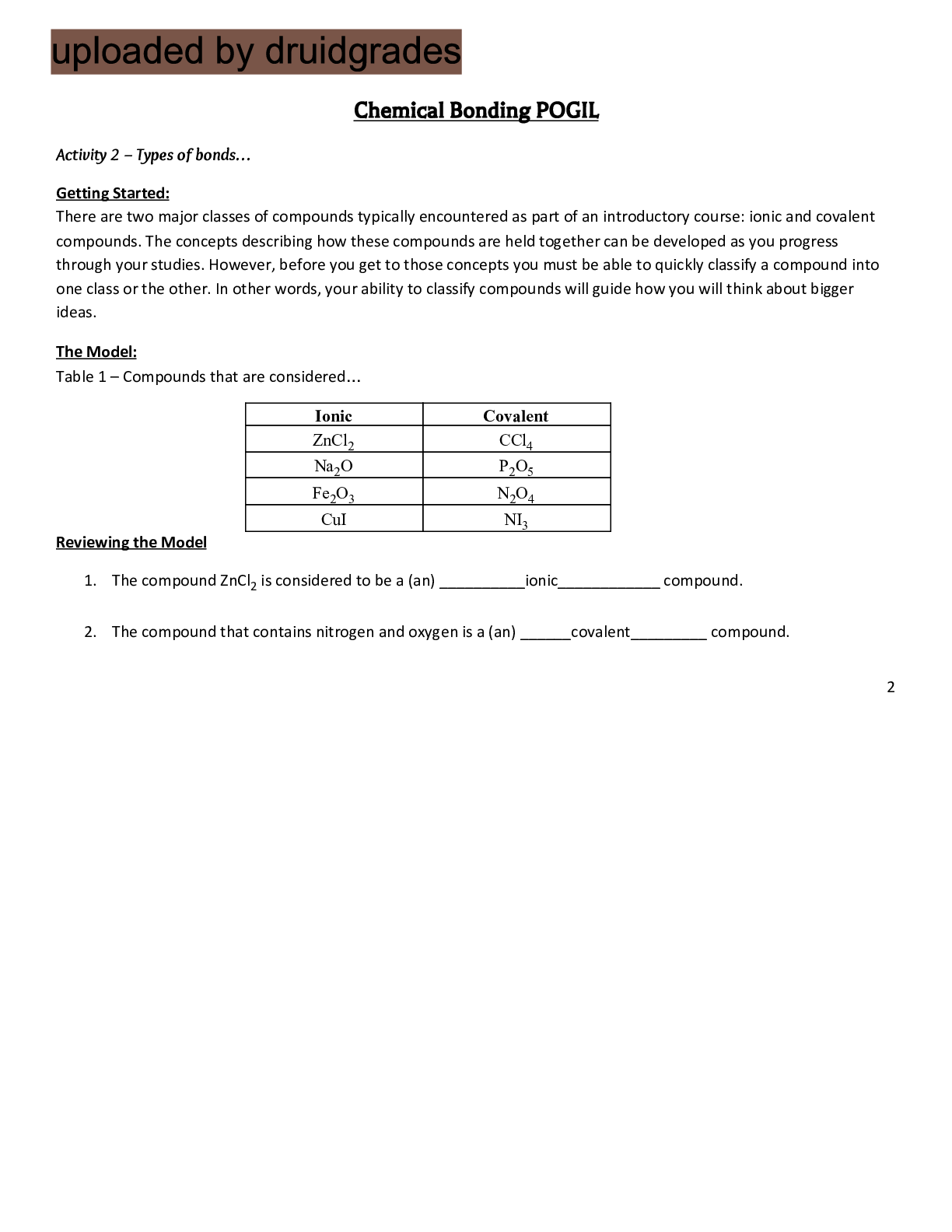
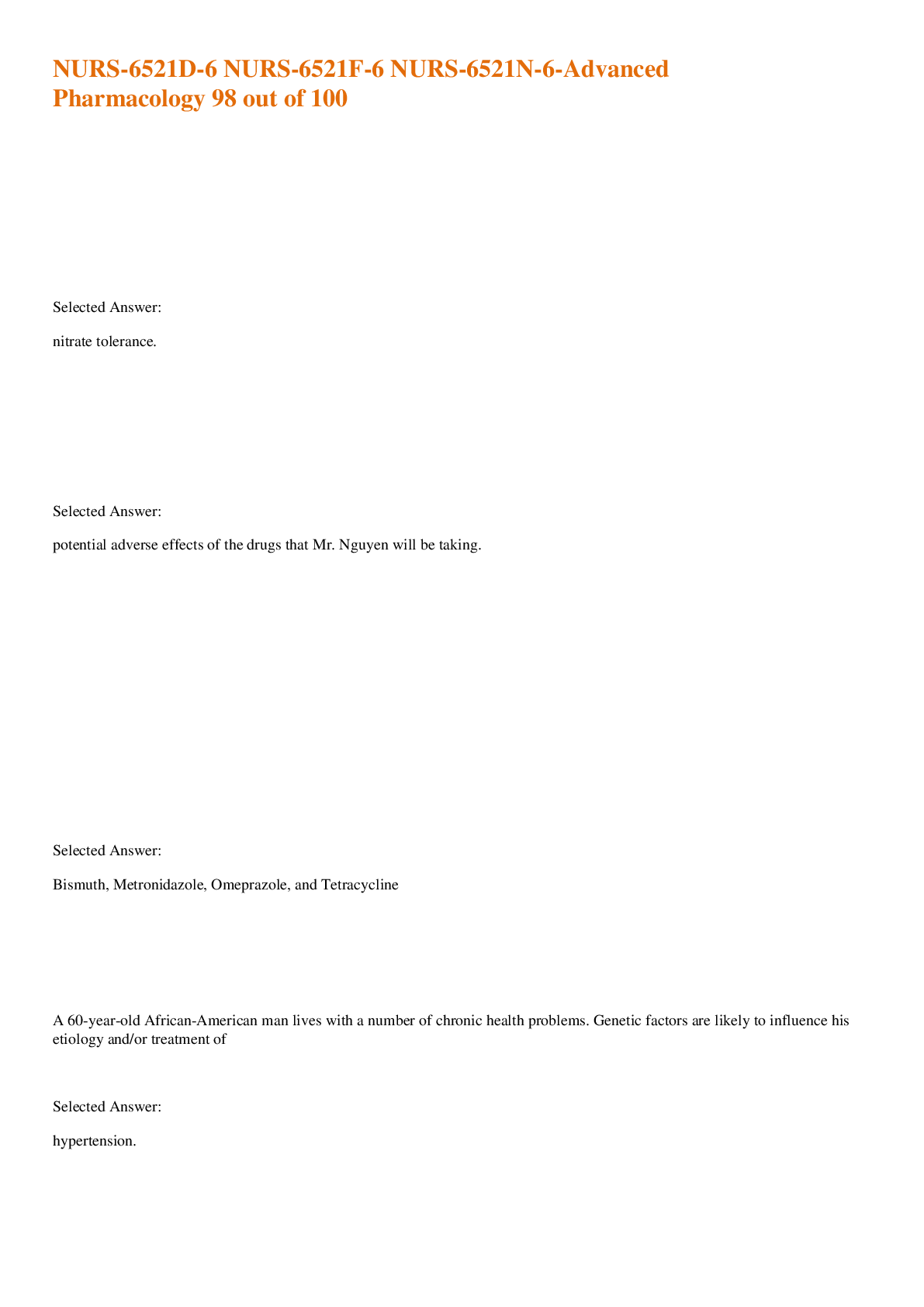

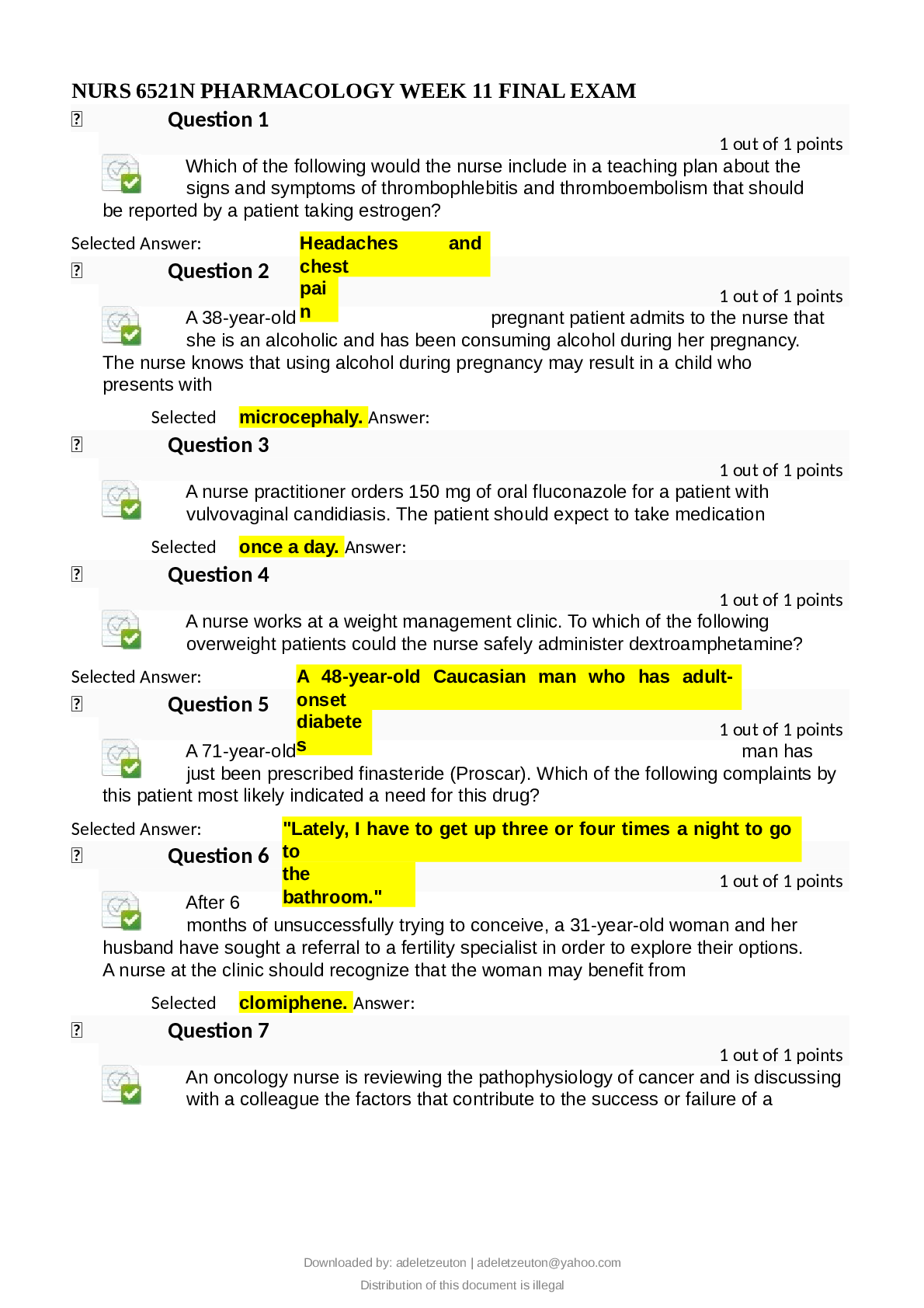

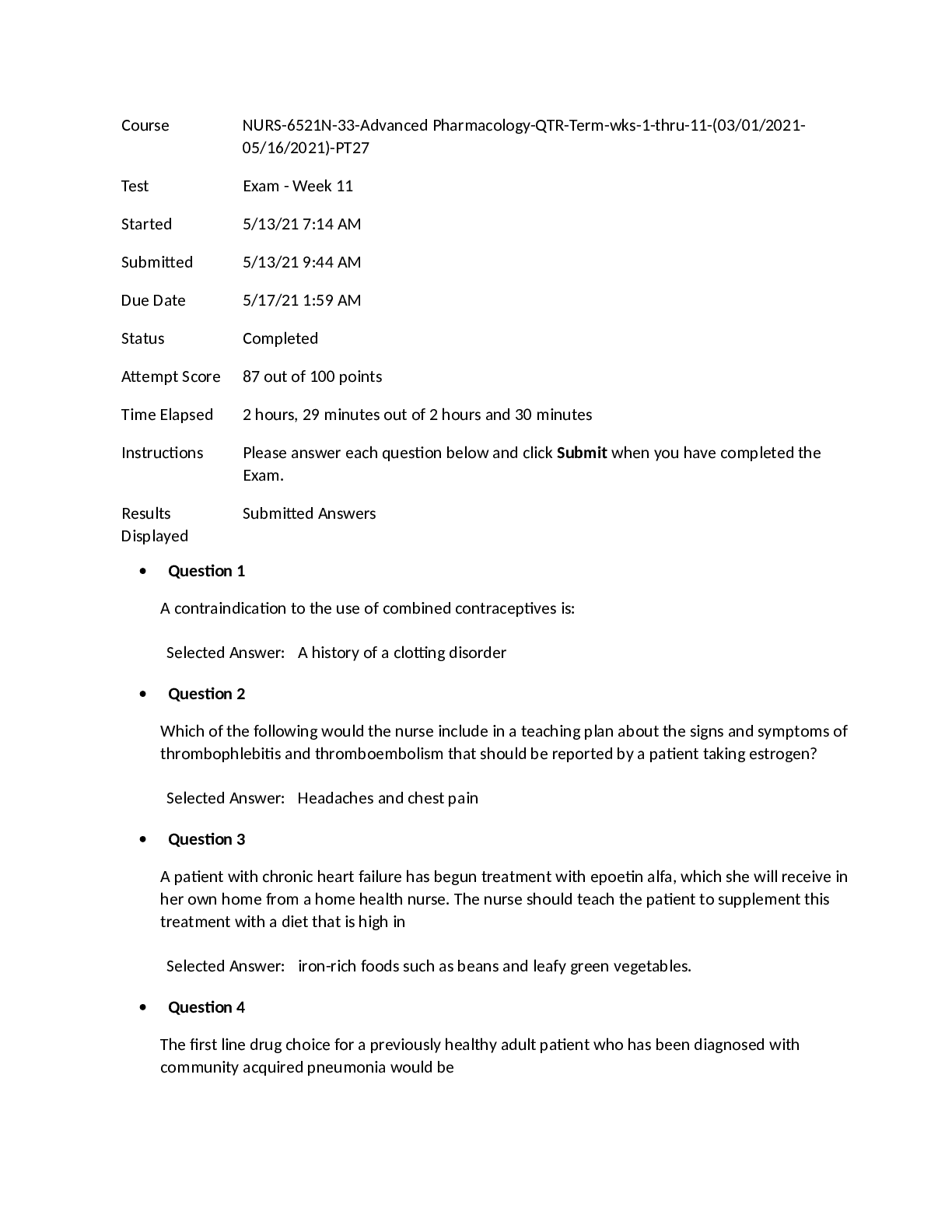
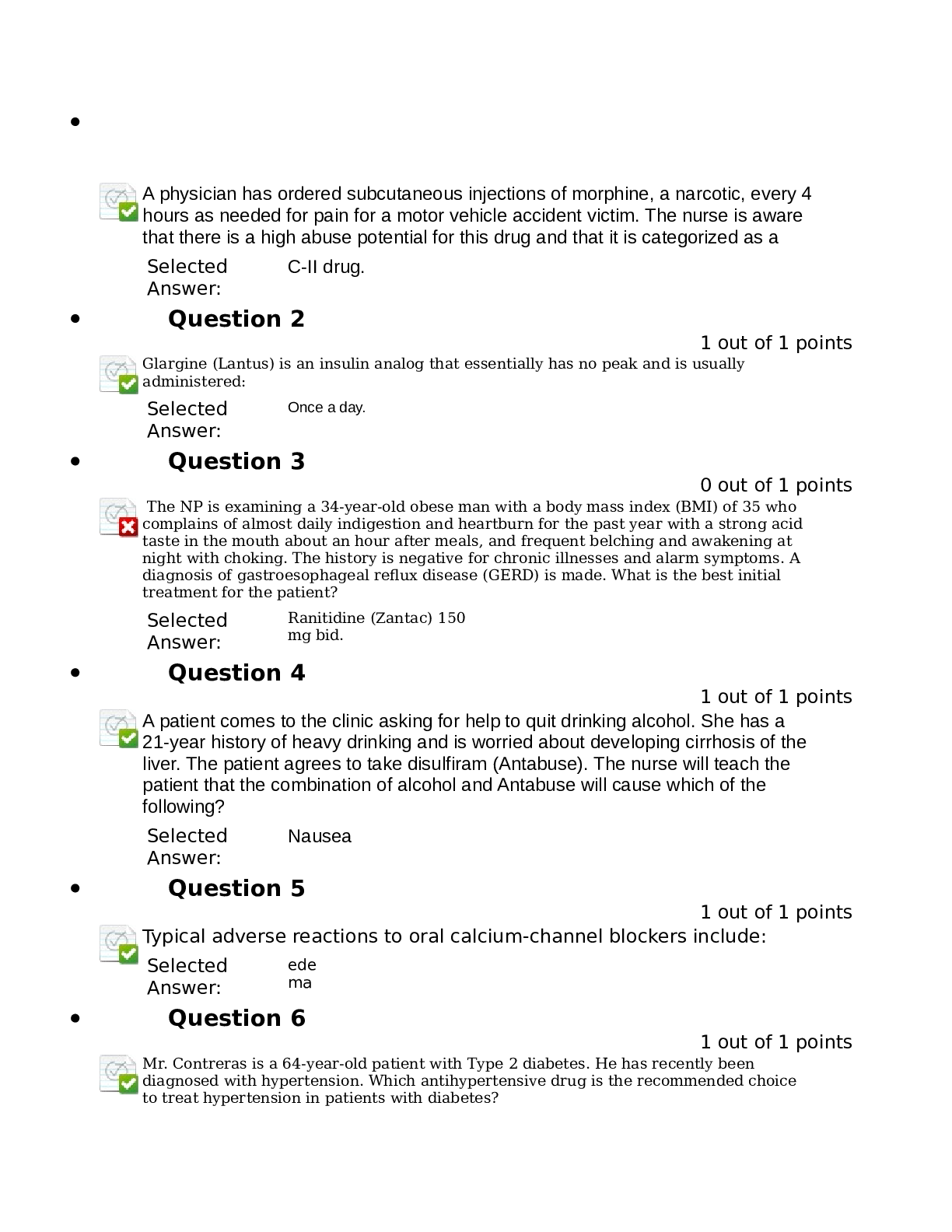
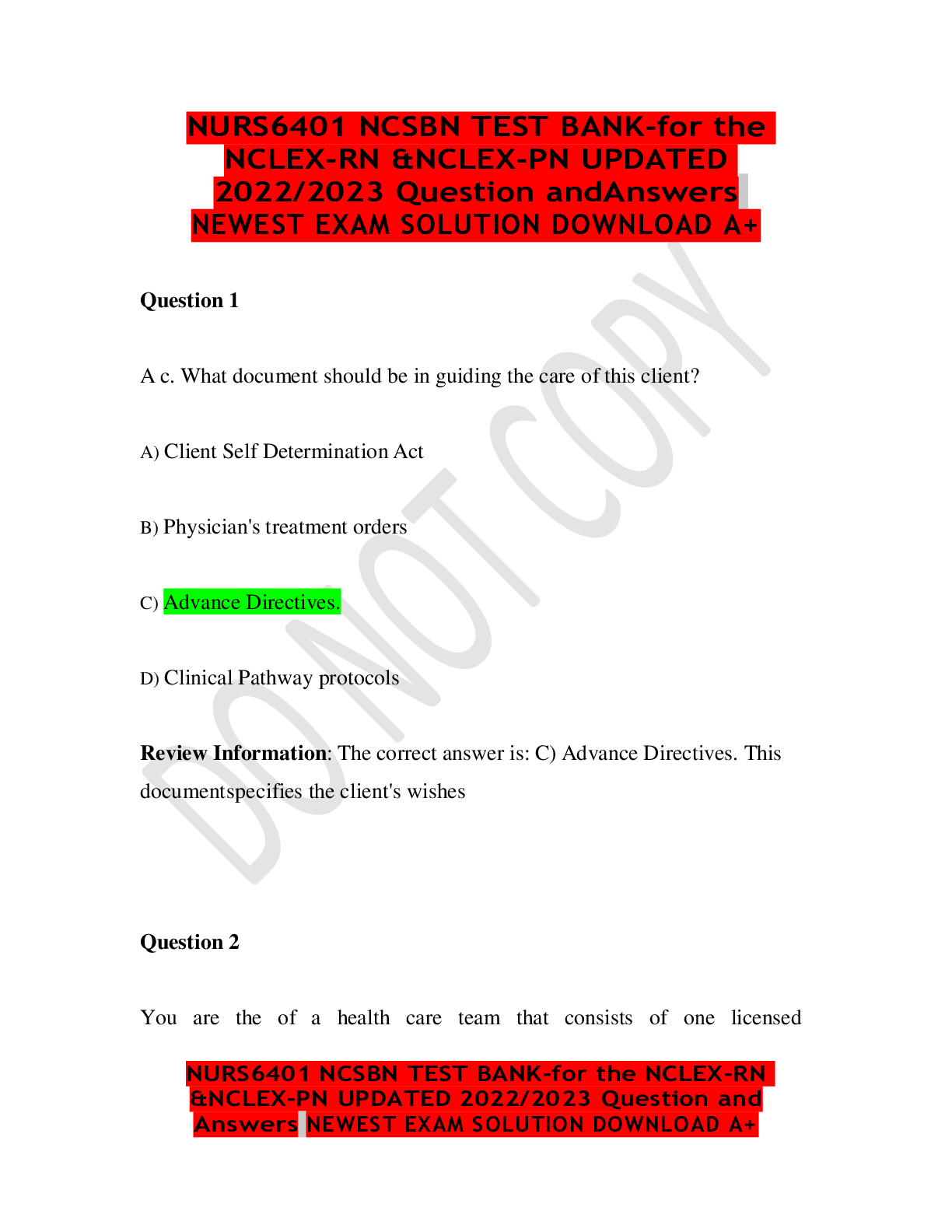



.png)
.png)
